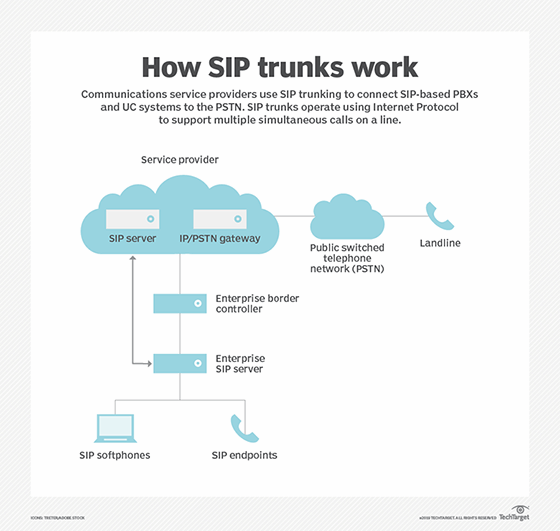What is SIP trunking (Session Initiation Protocol trunking)?
Session Initiation Protocol (SIP) trunking is a service a communications service provider offers that uses the protocol to provision voice over IP (VoIP) and multimedia connectivity between an on-premises phone system and the public switched telephone network (PSTN). The technology uses the SIP protocol to enable multimedia communications between endpoints over an Internet Protocol (IP) network.
SIP trunking is gaining in prominence as many countries replace traditional phone lines with VoIP. It allows for the provision of voice calls and other multimedia communications over IP networks.
The idea of SIP trunking has two main parts. SIP refers to the Session Initiation Protocol that is used to enable multimedia communications, such as voice, video and text messaging over an IP network instead of over a traditional analog/ISDN phone line. Trunking is the practice of consolidating different communication channels into a single trunk, a logical connection that allows multimedia communications over the internet.
SIP trunking architecture
SIP trunking architectures enable VoIP connectivity between on-premises private/local phone systems and a PSTN. They replace physical analog phone lines -- also known as primary rate interfaces (PRIs) -- with logical connections or SIP trunks.

A SIP trunk is a virtual phone line that connects a private branch exchange (PBX) to the PSTN. It may consist of 20 or more SIP lines or channels. SIP lines are the digital avatars of traditional phone lines. New lines can be added to the SIP trunk and architecture to allow communications (incoming and outgoing) between a corporate network and other phone/data networks with little and often no rewiring needed.
In addition, a SIP trunking architecture typically provides for a session border controller to mediate the connection between the SIP trunk and the on-premises phone system. SBCs provide a central point to manage security, call routing policy, numbering plans and transcoding of voice codecs.
The two other important elements of SIP trunking architecture are the SIP protocol and the SIP provider.
The SIP protocol is one popular method to deploy VoIP services. It facilitates a direct connection between a PBX and PSTN, removing the need for businesses (and individuals) to connect with other businesses (or individuals) without a legacy telephone line. SIP is not the same as VoIP. As a technology and protocol, SIP is much broader than VoIP since it supports both voice calls (using VoIP) and multimedia services over the internet.
SIP providers are the businesses that provide SIP VoIP services. In addition to voice and video calling, and instant messaging, they may also offer SIP services such as the following:
- Encryption and monitoring of voice calls and flagging of unexpected or potentially suspicious calls to meet security needs. Routing of calls to emergency services (such as 911 in the U.S. or 999 in the U.K.) with appropriate caller location information.
- Failover to backup trunks and locations.
- Ability to provision trunks via a web-based interface.
- Interconnection with cellular networks so a call placed to a cellphone also rings on a desktop phone.
- Protection against toll fraud.
- Denial-of-service protection.
- Virtual inbound phone numbers, including 800-number services.
- Business intelligence to business users using insights from call logs and machine learning algorithms.
- Usage, availability and performance reporting.
- The ability to route calls to multiple locations based on call volume, source of call or other policies.
Benefits of SIP trunking
From the customer perspective, SIP trunking is a more cost-effective method to enable business communications compared to traditional phone lines. The cost savings become particularly apparent if call volumes are high or if the business needs other multimedia services (video conferencing, instant messaging, etc.) in addition to voice calling. Also, some SIP providers offer flexible or pay-as-you-go pricing, allowing businesses to pay only for what they use. This gives them more control over their communications costs. The mechanism also unifies the business communication system, making it easier to manage, maintain, measure and optimize.
SIP trunking also offers greater purchasing flexibility than time-division multiplexing. TDM trunks typically support up to 23 voice channels, while SIP trunks can be purchased in any increment without requiring a dedicated wide area network (WAN) circuit.
Customers may implement SIP trunks over existing WAN services, dedicated WAN connections or even the internet. Additionally, businesses can add new channels to a SIP trunk without additional wiring since the trunk is logical rather than physical. This provides the scalability that businesses may need to suit their existing and expected call volumes, media types used, required support for concurrent calls, service availability targets, quality of service guarantees, business locations (domestic or international) and other factors.
SIP trunks also offer more reliable and higher-quality operations than analog phone lines. Since there is no fixed end-to-end route, a VoIP call can take any route to reach its destination, increasing the likelihood that it will reach that destination. Communications over SIP trunks can also avoid network issues or outages that often prevent analog calls from connecting, further increasing communication reliability and quality.
Applications of SIP trunking
SIP is used for call establishment, management and teardown. SIP trunking is typically sold as a replacement for digital PRIs, which are based on TDM.
Communications service providers worldwide have used SIP trunking extensively, often to replace their TDM-based services. By delivering SIP trunking over existing Ethernet or Multiprotocol Label Switching network infrastructure, the providers can reduce the cost and management complexity associated with legacy digital platforms, while delivering additional features their customers require.
SIP trunking is preferred over PRI and Basic Rate Interface (BRI) telecommunications lines because it offers more savings, greater flexibility and more integration with newer technologies. Explore the differences between SIP trunking, PRI and BRI.







